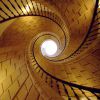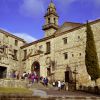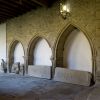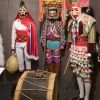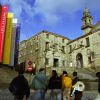- Accede I
- Regístrate I
- carrito
Museo do Pobo Galego
El antiguo convento de Santo Domingo de Bonaval, situado en una colina extramuros de la ciudad histórica, junto al camino por el que los peregrinos llegaban a Compostela, acoge hoy el Museo do Pobo Galego, que a través de un amplio y variado conjunto de piezas ofrece una panorámica de las manifestaciones más representativas de la cultura propia de Galicia. Sus salas permanentes muestran diversos aspectos del mundo del mar, los oficios tradicionales, el campo, la indumentaria y la arquitectura popular. Dispone, además, de secciones de arqueología, pintura y escultura gallegas. Regularmente se organizan exposiciones temporales de temática diversa.
El Museo del Pueblo Gallego se constituyó bajo los auspicios de un Patronato integrado por entidades y personas que trabajan en las distintas áreas de la cultura gallega y por representaciones de instituciones públicas y académicas. Se inauguró en octubre de 1977, en el edificio cedido por el Ayuntamiento de Santiago de Compostela.
El convento de Bonaval, fundado en el siglo XIII por Santo Domingo de Guzmán, fue reconstruido en estilo barroco en los siglos XVII y XVIII. La parte más notable fue proyectada por el arquitecto Domingo de Andrade. En el interior se puede admirar una original escalera helicoidal triple.
La iglesia data de la época de la fundación. Es de estilo gótico y sufrió diversas reformas y adiciones hasta el siglo XVI. En ella está emplazado el Panteón de Galicia, en el que reposan los restos de la poetisa Rosalía de Castro, el político regionalista Alfredo Brañas, el escultor Francisco Asorey, el poeta Ramón Cabanillas, el geógrafo Domingo Fontán y el artista y político nacionalista Alfonso R. Castelao.

















